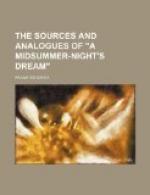But four years later, as we have seen,[85] Nashe confounds elves with fairies in deriving all alike from fauns and dryads. Robin is “mad-merry,” “jocund and facetious,” “a cozening idle friar or some such rogue” [in origin], and so forth—simply described by Shakespeare as a “shrewd and knavish sprite.” The forms of mischief in which he delights are described in A Midsummer-Night’s Dream, II. i. 33-57, and all these “gests” may be found in the contemporary Robin Goodfellow literature;[86] though we have observed that some of the functions attributed to Queen Mab in Mercutio’s famous speech[87] belong rightly to Robin.[88]
Thus we see—to take into consideration but a few points of the myth—that the fairy-superstition and the elf-superstition were melted together in the popular pre-Shakespearean mind, and that Shakespeare himself, making a new division of the characteristics of the two, yet re-welded the whole into one realm by putting the Puck in subjection under the fairy king.
The main characteristics of Shakespeare’s fairies, then, may be summarised shortly:—[89]
They are a community under a king and queen, who hold a court; they are very small, light, swift, elemental; they share in the life of nature; they are fond of dancing and singing; they are invisible and immortal; they prefer night, and midnight is their favourite hour; they fall in love with mortals, steal babies and leave changelings, and usurp the function of Hymen in blessing the marriage-bed. Oberon, “king of shadows,” can apparently see things hidden from Puck.[90]
Titania, “a spirit of no common rate,” is yet subject to passion and jealousy, and had a mortal friend, “a votaress of my order."[91]
The fairy of folk-lore in Shakespeare’s day is nearly everything that the fairies of A Midsummer-Night’s Dream are; we may possibly except their exiguity, their relations in love with mortals, and their hymeneal functions. His conception of their size as infinitesimal at least differs from that of the popular stories, where (as far as can be ascertained) they are shown to be about the size of mortal children.
We may conclude these remarks with the modern Irish-Catholic theory of the origin of the fairies:—
“When Lucifer saw himself in the glass, he thought himself equal with God. Then the Lord threw him out of Heaven, and all the angels that belonged to him. While He was ‘chucking them out,’ an archangel asked Him to spare some of them, and those that were falling are in the air still, and have power to wreck ships, and to work evil in the world."[92]
* * * *
OBERON’S VISION.




